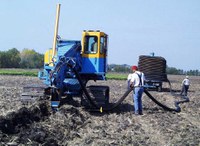Managing Subsurface Water in the Field Can Pay Off
(Click the image below to view a high-resolution image that can be downloaded)
The small-grain, canola and field pea crop harvest is nearing completion and preparation and planning are starting to take place for next year. Cool-season crops that were planted early tended to have the highest yield potential this year.
During some parts of the 2007 growing season, there were many fields with saturated soil conditions, which delayed planting or caused crop injury in lower parts of the fields. Water management is an important factor in crop production, but many producers already have surface drainage ditches in their fields.
""The next management step is to consider if the subsurface moisture can be managed as well,"" says Hans Kandel, North Dakota State University Extension Service agronomist. ""Water management is the use of surface ditches and/or subsurface permeable pipes to remove standing or excess water from poorly drained fields."
During the late 1800s, European settlers in the upper Midwest began digging drainage ditches to remove excess water from the wet areas of their fields and move the water to nearby streams and rivers. Later, producers in what is the Corn Belt increased drainage by installing subsurface drainage pipes at a depth of approximately 3 feet.
Until the 1970s, most subsurface drainage pipes were made from short, cylindrical sections of concrete or clay called ""tile."" Terms such as tile, tile drainage and tiling still are used even though most drainage pipe now is made of perforated polyethylene tubing.
When installing a subsurface drainage system, pipes are placed strategically in a field to remove water from isolated wet areas or installed in a pattern to drain an entire field. Many soils in North Dakota have poor natural internal drainage and remain waterlogged for several days after excess rain. This prolonged wetness prevents timely fieldwork and causes stress on crops because saturated soils do not provide sufficient aeration for root development. The roots of most crops grown in North Dakota cannot tolerate excessively wet conditions for more than a few days.
Farmers must make a significant financial investment when installing an agricultural subsurface drainage system. This investment often is made for these reasons:
- Tile drainage usually increases crop yields (and potential quality) on poorly drained soils by providing a better environment for plants to grow, especially during years with wet periods.
- The systems generally help improve field conditions for timely tillage, planting, spraying and harvesting.
- The drainage systems are long-term improvements in the farming operation and tax laws allow writing off tile drainage costs (see your accountant).
""Agricultural engineers have developed depth and spacing guidelines for installing drainage pipes,"" Kandel says. ""The newest and most comprehensive system available is controlled drainage, which has become recognized as an effective practice. This practice involves placing simple water control structures at various locations in the tile system to control the water table in the soil based on the management decisions of the producer.""
It takes time to design a tile drainage system for a field and to obtain the necessary permits. The best period to tile a piece of land is after cool-season crops have been harvested. Tiling can be done until the soil freezes.
Information about tile drainage in our region can be found at http://d-outlet.coafes.umn.edu/.
NDSU Agriculture Communication
| Source: | Hans Kandel, (701) 231-7122, hans.kandel@ndsu.edu |
|---|---|
| Editor: | Rich Mattern, (701) 231-6136, richard.mattern@ndsu.edu |


